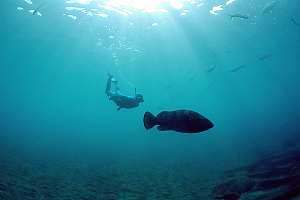 |
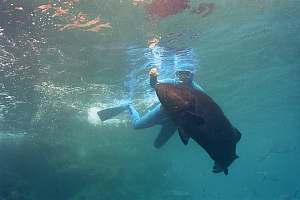 |
For their giant groupers alone, the Kermadec Islands are worth visiting. Some are over 50kg and 50 years old. They can grow even larger (to 2.0 metres weighing 150-180 kg!) and older. Miraculously, these impressive, intelligent and inquisitive fish have been spared their extinction, their fate almost everywhere else in the world, and regrettably also around the main islands of New Zealand. Now they are fully protected, their human visitors behave in friendly ways, bringing a welcome change to the boredom of their fishy lives. In New Zealand known as spotted black groupers (Epinephelus daemelii) these large fish are limited to the subtropical waters of northern New Zealand, Three Kings Islands, Norfolk Island and the Kermadecs, eastern Australia, Elizabeth Reef and Middleton Reef, which amounts to a very small habitat area on the globe. This makes them rare. In Australia they are known as saddled rock cod or black rock cod, but their numbers have been greatly reduced by spearfishing and line fishing.
Born as females, the larger groupers turn into males later in life (at a length of about 1.0m), surrounding themselves with harems of half a dozen or more smaller females. Groupers are usually found where the sandy bottom meets the rocky shore, and where a cave or sheltering canyon is nearby. They seek the shelter of such places, to hang suspended in the water while watching the goings-on. Several times each day, they patrol their huge territories in search of easy prey, usually sick animals. The spotted black groper has huge jaws with sharp conical teeth, suitable for holding prey animals. It is an intelligent and inquisitive fish, perhaps capable of hunting in co-operative groups.
Like other groupers, this fish can change its colouring while you watch, from black to grey to brown to white and spotted with five clear oblique bands.
The photos we selected, show how these large fish interact with snorkeldivers. Enjoy your swim!
Note! for best printed results, set your page up with
a left margin of 1.5cm (0.6") and right margin of 1.0cm (0.4")
-- home -- issues
index -- marine reserves index -- Kermadec
index -- site map --
Rev:20020624,20020719,
 |
 |
 |
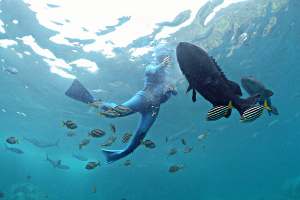 |
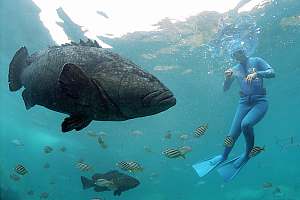 |
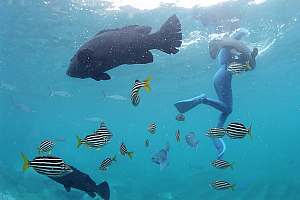 |
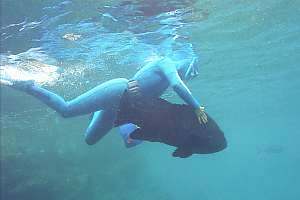
f031608: A large female allows herself to be stroked, not at all in a hurry to leave. Because visitors to Raoul are relatively rare, and snorkeldivers rarer still, such encounters are not an everyday event, and both species have to get used to one another, which involves trust. |
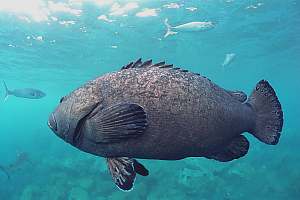
f031701: Close-up of a large female which has just changed colour. She is well-fed, but the lens distorts her belly somewhat. Notice the light blue fringes on her fins. |
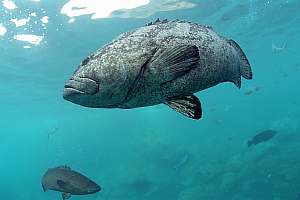
f031715: Close-up of a large female grouper. |
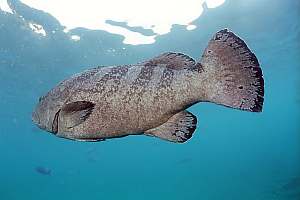
f031716: Side and tail of a female grouper. |
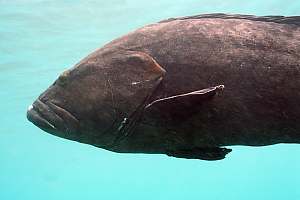
f031600: Close-up of White-lip, the large male grouper. He is easily identified by some white spots on his bottom lip and left gill cover, as these blemishes fail to change colour. |
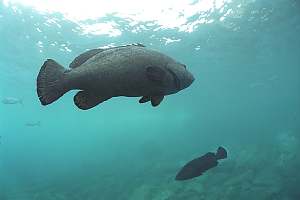
f031700: female groupers. |
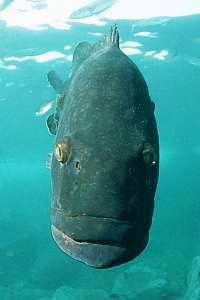 |
 |
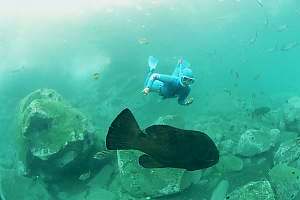
f031717: A snorkeldiver has dived down to meet one of the female groupers. |
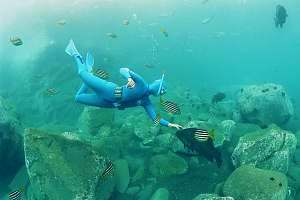 |
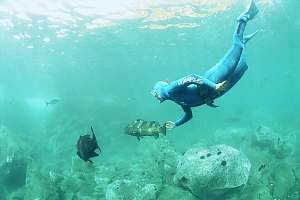
f031719: Two young groupers have come to learn the ropes, but they are much more wary than the older ones. |
 |
| White-lip was not at all impressed with the photographer
who failed to cuddle him. So he came up from behind and gave the shutterbug
a good thump with his lower jaw; then rubbed his large body all over the
photographer's shoulder and neck. The bottom of the lower jaw feels like
a hard bony plate, which groupers apparently use for thumping. Irealised
he sought attention and I began stroking his massive body with coarse scales.
he held me tight with his pectorals as he curved his body around my back,
lifting my leg with his tail fin - a backside embrace. Then he made a frontal
embrace, with his head down, showing how much he liked my skin rubs by
changing to a mottled white colour all over. For good measure I dropped
my camera on the 6m deep sandy bottom.
The females whowatched all this, hurried closer in excitement, demanding their turns while also becoming mottly white. It showed me that these wild animals do have emotions resembling affection and that the food was of little importance. Once I collected my camera, they became moreinterested in my buddy for a cuddle. Smaller groupers were too shy though. When we returned to the rubber dinghy, parked further away, the groupers first stayed away, then turned out in full. While I was kneeling on the sandy bottom and fanning the sand to study what it is made of, White-lip suddenly approached frontally. He laid his large head on my folded knees and looked up to meet my eyes. I stroked him gently, for as long as my breath allowed, while he kept totally still. I then reluctantly had to leave for the surface, gasping for air. White-lip gave another glance, then swam away to the six females who were waiting for him by the anchor, the group disappearing out of sight in the direction of their home. It was late in the afternoon and the fish retired to their den behind(east of) Fishing Rock. In all, we spent three snorkel dives of several hours with these gentle giants. It gave them the time needed to get used to us and to trust our good intentions. The first dive we didn't even bring our cameras. We brought some food to break the ice, which helped. But they were more interested in us as other intelligent beings, than in the food we brought. A personal account - Floor Anthoni |